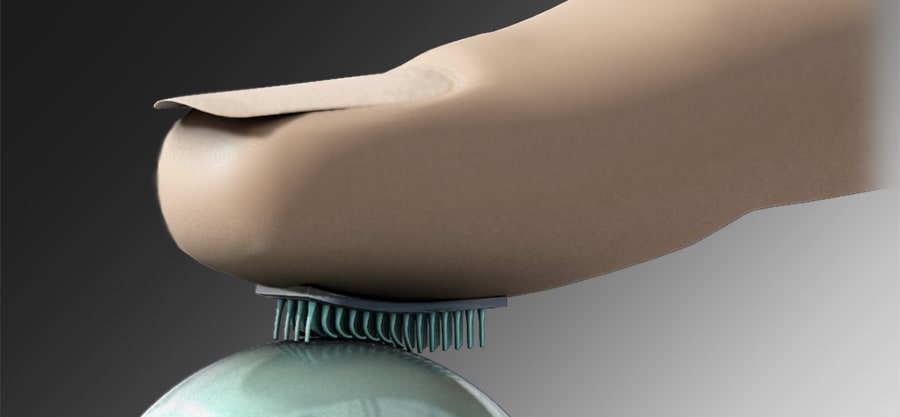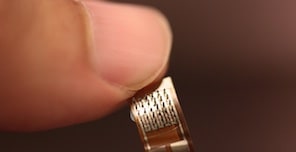An Artificial Skin That Can Feel
A novel approach to realize highly sensitive, power efficient and multifunctional tactile sensors

This KAUST technology relates to a novel approach to realize highly-flexible tactile sensors. The versatility of this sensor enables it to operate in water and air environments. It also has the ability to measure vibration, touch and flow, which is unique in the realm of tactile sensors.
This invention consists of highly elastic and magnetic nanocomposites integrated on a magnetic-sensing element. The current nanocomposites are made from metal-based nanowires. A distinct advantage of this technology is the permanent magnetic behavior of the nanowires. It allows for remote operation without any external magnetic fields and ensures minimal power consumption and simple system integration.
This technology can also easily customize the sensors’ performance by tuning the nanowires arrangements and dimensions. This highly-controllable concept can also work in both rigid and flexible substrates. It combines miniaturization with high sensitivity and low power consumption to cover a wide range of applications.
Technology summary
Extensive research has been conducted seeking alternative routes to mimic the functionality of human biological skin. Artificial skin, commonly referred to as electronic skin (e-skin), can be used to replace burned skin, on prosthetic limbs, and to add a realistic sense of touch on robots. The KAUST technology offers a magnetic flexible device suitable for artificial skin applications.
How it works
Extensive research has been conducted seeking alternative routes to mimic the functionality of human biological skin. Artificial skin, commonly referred to as electronic skin (e-skin), can be used to replace burned skin, on prosthetic limbs, and to add a realistic sense of touch on robots. The KAUST technology offers a magnetic flexible device suitable for artificial skin applications.
This flexible tactile sensor is built using magnetic iron nanowires embedded in a plastic polymer (nanocomposite) to mimic the cilia structure. Cilia are thin tail-like projections, found in most human cells, which are used to move cells and fluids around. These cilia have permanent magnetic behavior and stray magnetic fields because of the nanowires, and they are highly elastic because of the polymers. The cilia-like structures are integrated on top of a magnetic sensor, so when external pressure is applied, the structures bend resulting in a change in the sensed magnetic fields that reconstruct the sense of touch.
Why it is better
This KAUST sensor technology combines high sensitivity with low power consumption. The sensors have the ability to measure vibration, touch and flow in both air and water environments.
A photograph of a flexible tactile sensor with an inset showing an SEM image of the cilia, and a photograph showing the flexible sensor attached to the skin above an artery on the wrist.
IP protection
Patents pending
Invention track code
2014-066

Benefits
- Cost-effective process fabrication
- Sensor fabrication on both rigid and flexible substrates
- Wide range of sensor flexibilities to cover different sensitivities under different regimes
- Ability of the sensor to measure flow, vibration and touch
- Ability of wireless operation
- Sensor can operate in air and water environments

Applications
- Microfluidics
- Biological detection and surgery tools
- Electronic skins
- Health monitoring systems
- Smart gloves for robotics
- Flexible electronics
